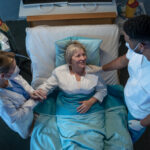
The Demise of the Inpatient-Only List Begins
It finally happened! The Centers for Medicare & Medicaid Services (CMS) finally released the 2026 Outpatient Prospective Payment Final Rule on Friday at 4:15 pm,

February is American Heart Month.
Takotsubo syndrome is also known as broken heart syndrome. According to the American College of Cardiology, it typically occurs following an emotional or physical stressor.
Left ventricular dilation and acute systolic heart failure occur. It is thought that a surge of stress-related hormones contributes to left ventricular ballooning. In case you ever wondered why it is named takotsubo syndrome, “takotsubo” is the Japanese word for an octopus trap. When the left ventricle balloons out, it takes the shape of one.
Some interesting facts about broken heart syndrome include that about 90 percent of worldwide cases occur in post-menopausal women. In Japan, however, the syndrome is more common in men, and they are likely to develop it following instances of physical stress.
Another interesting note is that while the Mayo Clinic does have diagnostic criteria, broken heart syndrome is often diagnosed when a patient who is suspected to have had an acute myocardial infarction undergoes a cardiac catheterization, and no coronary blockage is found.
Happily, about 95 percent of patients have a full recovery of cardiac function within several weeks of diagnosis. While broken heart syndrome is not found in the Alphabetic Index, takotsubo syndrome is found, and would be assigned to I51.81. It is considered to be a complication or comorbidity (CC).
Have you ever wondered why mononucleosis is also called “kissing disease?” Mono is spread through physical contact, with saliva being a common means of transmission. The Cleveland Clinic notes that this disease is very common among teenagers and young adults. It also notes that while mono isn’t a serious illness for most people, it can make you feel very fatigued and achy for about a month – which may be a small price to pay for true love!
Cleveland Clinic also noted an interesting fact about this condition, noting about 95 percent of Americans get this infection by the time they are 35. Not everyone who has the virus develops mono; some people just carry the virus. Category B37 classifies infectious mononucleosis.
The code options include codes for gamma-herpesviral, cytomegaloviral, other infectious, and an unspecified option. Within each of these code options are further selections to identify cases without complications, with polyneuropathy, with meningitis, and with other complication.
While there is no Alphabetic Index for kissing disease, there is an index entry for Kissing Spine. M48.2 Kissing Spine is also known as Baastrup’s syndrome or Baastrup’s sign. It occurs when two adjacent vertebrae touch each other or “kiss,” causing pain and inflammation.
While it can affect any area of the spine, HealthCentral notes that it is most common in the lumbar spine, specifically the L4-L5 segment. M48.20-M48.27 is the code range covering the levels of the spine.
Kissing spine cannot be diagnosed by physical examination only; imaging scans will be needed for diagnosis confirmation. Humans aren’t the only ones who can develop kissing spine, as the condition is also known to affect horses.
Have a healthy American Heart Month!


It finally happened! The Centers for Medicare & Medicaid Services (CMS) finally released the 2026 Outpatient Prospective Payment Final Rule on Friday at 4:15 pm,

EDITOR’S NOTE: Ritesh Ramesh, CEO for MDaudit, appeared on Monitor Monday to report his company’s findings on nationwide audit trends. The rate of payer audits
Please log in to your account to comment on this article.

Accurately determining the principal diagnosis is critical for compliant billing, appropriate reimbursement, and valid quality reporting — yet it remains one of the most subjective and error-prone areas in inpatient coding. In this expert-led session, Cheryl Ericson, RN, MS, CCDS, CDIP, demystifies the complexities of principal diagnosis assignment, bridging the gap between coding rules and clinical reality. Learn how to strengthen your organization’s coding accuracy, reduce denials, and ensure your documentation supports true medical necessity.

Denials continue to delay reimbursement, increase administrative burden, and threaten financial stability across healthcare organizations. This essential webcast tackles the root causes—rising payer scrutiny, fragmented workflows, inconsistent documentation, and underused analytics—and offers proven, data-driven strategies to prevent and overturn denials. Attendees will gain practical tools to strengthen documentation and coding accuracy, engage clinicians effectively, and leverage predictive analytics and AI to identify risks before they impact revenue. Through real-world case examples and actionable guidance, this session empowers coding, CDI, and revenue cycle professionals to shift from reactive appeals to proactive denial prevention and revenue protection.

Sepsis remains one of the most frequently denied and contested diagnoses, creating costly revenue loss and compliance risks. In this webcast, Angela Comfort, DBA, MBA, RHIA, CDIP, CCS, CCS-P, provides practical, real-world strategies to align documentation with coding guidelines, reconcile Sepsis-2 and Sepsis-3 definitions, and apply compliant queries. You’ll learn how to identify and address documentation gaps, strengthen provider engagement, and defend diagnoses against payer scrutiny—equipping you to protect reimbursement, improve SOI/ROM capture, and reduce audit vulnerability in this high-risk area.

Only ICD10monitor delivers what you need: updates on must-know changes associated with the FY26 IPPS, including new ICD-10-CM/PCS codes, CCs/MCCs, and MS-DRGs, plus insights, analysis and answers to your questions from two of the country’s most respected subject matter experts.

Get clear, practical answers to Medicare’s most confusing regulations. Join Dr. Ronald Hirsch as he breaks down real-world compliance challenges and shares guidance your team can apply right away.

Federal auditors are zeroing in on Inpatient Rehabilitation Facility (IRF) and hospital rehab unit services, with OIG and CERT audits leading to millions in penalties—often due to documentation and administrative errors, not quality of care. Join compliance expert Michael Calahan, PA, MBA, to learn the five clinical “pillars” of IRF-PPS admissions, key documentation requirements, and real-life case lessons to help protect your revenue.

During this essential RACmonitor webcast Michael Calahan, PA, MBA Certified Compliance Officer, will clarify the rules, dispel common misconceptions, and equip you with practical strategies to code, document, and bill high-risk split/shared, incident-to & critical care E/M services with confidence. Don’t let audit risks or revenue losses catch your organization off guard — learn exactly what federal auditors are looking for and how to ensure your documentation and reporting stand up to scrutiny.

Learn how to navigate the proposed elimination of the Inpatient-Only list. Gain strategies to assess admission status, avoid denials, protect compliance, and address impacts across Medicare and non-Medicare payors. Essential insights for hospitals.
Prepare for the 2025 CMS IPPS Final Rule with ICD10monitor’s IPPSPalooza! Click HERE to learn more
Get 15% OFF on all educational webcasts at ICD10monitor with code JULYFOURTH24 until July 4, 2024—start learning today!
CYBER WEEK IS HERE! Don’t miss your chance to get 20% off now until Dec. 1 with code CYBER25
CYBER WEEK IS HERE! Don’t miss your chance to get 20% off now until Dec. 2 with code CYBER24